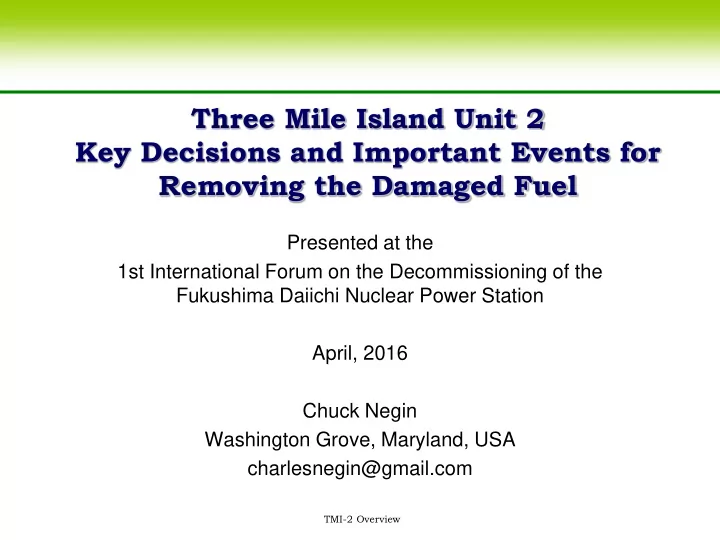

Three Mile Island Unit 2 Key Decisions and Important Events for Removing the Damaged Fuel Presented at the 1st International Forum on the Decommissioning of the Fukushima Daiichi Nuclear Power Station April, 2016 Chuck Negin Washington Grove, Maryland, USA charlesnegin@gmail.com TMI-2 Overview
Damaged Fuel and Debris 2 TMI-2 Overview
Damage Examples TMI-2 Overview 3
Various Areas for Defueling Core Cavity Lower Support Grid Flow Distributor Behind and within the Core Baffle Plates Lower Head Elsewhere in the Reactor Systems Bottom of the Upper Core Support Assembly Reactor Pressure Vessel Cutaway View TMI-2 Overview 4
Defueling Progress and Key Impacts 1983 1982-1983 1982 1983 Sonar Mapping & Defueling Options Evaluations First Video of Core First Sample Improved Video 1984 Vessel Defueling Progress Defueling Method Decision Dry Canal & Mostly Manual Feb-1990 100% May-1989 Core Former 90% Mid-1984 Disassembly Lower Grid Vessel Head Lift 80% Cutting Dec-1988 70% Dec-1987 60% 50% Sept-1987 40% Lost Water Clarity 30% April-1987 20% Dec-1986 Feb-86 10% 0% Oct-1985 Oct-85 Apr-86 Nov-86 May-87 Dec-87 Jun-88 Jan-89 Aug-89 TMI-2 Overview 5
Removal Methods Five concepts for fuel removal before visual characterization ; none were used: Dual Telescoping Tube, Manipulator Manual Defueling Cylinder Indirect Defueling Cylinder Flexible Membrane Dry Later, a remotely operated service arm, shredder, and vacuum transfer system was considered and rejected Final method chosen was an adapted mining drill (the core bore) and manual methods TMI-2 Overview 6
Core Boring Machine Adapted from commercial mining drilling equipment One of the most important machines for the project First use with hollow core bits: 10 samples 1.8 m long x 6.4 cm diameter (figure below) Second use with solid face bits to chew through the hard once-molten mass in the core region Third use was assisting lower grid and instrument tubes by grinding metal (next viewgraph) Tungsten Carbide Teeth with Synthetic Diamond TMI-2 Overview 7
Fuel Removal Tools and Equipment Some Manual Tools Powered Equipment Core Boring Machine Plasma Arc Power Assisted shears Bulk Removal Water Vacuum and Air Lift Manual Controlled Equipment Grippers Buckets TMI-2 Overview
Work Platform TMI-2 Overview
Three Canister Design – 341 Shipped 10 Knockout Canisters 60 Filter Canisters 271 Fuel & Debris Canisters (for vacuum tools) (water processing) TMI-2 Overview 10
Packaging & Transport Canister Staging in Spent Fuel Pool Transfer Cask Operations TMI-2 Overview 11
Staging & Shipping Loading the Shipping Cask Shipping Cask TMI-2 Overview 12
Packaging, Transport, & Storage at Idaho Idaho National 3400 km Laboratory Three Mile Island 1986 to 1990 341 canisters of fuel & debris in 46 shipments by rail cask to the Idaho National Laboratory 1990 to 2000 Wet Storage in Spent Fuel Storage Pool 2000 – 2001 Removed from pool, dewatered, dried, and placed in dry storage TMI-2 Overview 13
Possible Remaining Fuel Particulate Residual Fuel* RPV: < 900 kg In the Reactor Coolant System: < 133 kg Criticality ruled out by analysis Assessment Required a Combination of* Video inspection for locations Gamma dose rate and spectroscopy Passive neutron solid state track recorders, activation, BF3 detectors Active neutron interrogation Alpha Detectors Sample Analysis TMI-2 Overview 14
Events/Decisions(1) Events/Decisions Significance Decisions for removal First idea of what conditions really were; complete assessment required visual took another year; could not proceed to plan defueling without characterization this knowledge • New application for the proposed technology, concern that Decision to not to install in-core shredding failure would cause problems, relied mostly on manual equipment in the vessel manipulation with power assist • Allowed defueling to start earlier, knowing that overall schedule would not be minimized. This was preferred over a 3 year development for a remote system/equipment • Less depth for manually operated tools Decision to leave refueling • Shielded work platform 2m above the reactor pressure vessel canal dry flange • Reduced need for water processing • Dose rates were low within the refueling canal • Use of Core Boring Samples of the fuel and debris that was melted together • Machine was essential Breaking up the crust and molten mass when manual methods were unsuccessful TMI-2 Overview 15
Events/Decisions(2) Events/Decisions Significance Unanticipated biological Caused a year delay; managing water clarity is extremely growth in water fouled important filters • DOE to take Fuel & Debris Handling and shipping design and fabrication could not take New cask design and place until destination was determined • license Allowed fuel & debris canisters to be removed from TM • Ship Fuel to Idaho by Rail New cask could be designed for the TMI canisters • and not Truck Fewer shipments Transfer to Dry Storage Long term storage stability, also allowed demolition of fuel pool at Idaho TMI-2 Overview 16
Recommend
More recommend